Table of Contents |
In previous lessons, you learned about the basic process of photosynthesis through which some organisms can harness the sun's energy, converting it into chemical energy that allows them to use inorganic molecules (such as carbon dioxide) to produce organic molecules. You also learned about chloroplasts that all photosynthetic eukaryotic cells use for photosynthesis.
Prokaryotic cells do not have chloroplasts, but many prokaryotes are still capable of carrying out photosynthesis using systems of membranes that share similarities with chloroplasts.
The image below shows a chloroplast in part (a) and a thylakoid membrane of a photosynthetic prokaryote in part (b). Note that the chloroplast has outer and inner membranes giving it a distinctive overall structure, whereas the prokaryote has thylakoid membranes that are not enclosed within a similar structure.
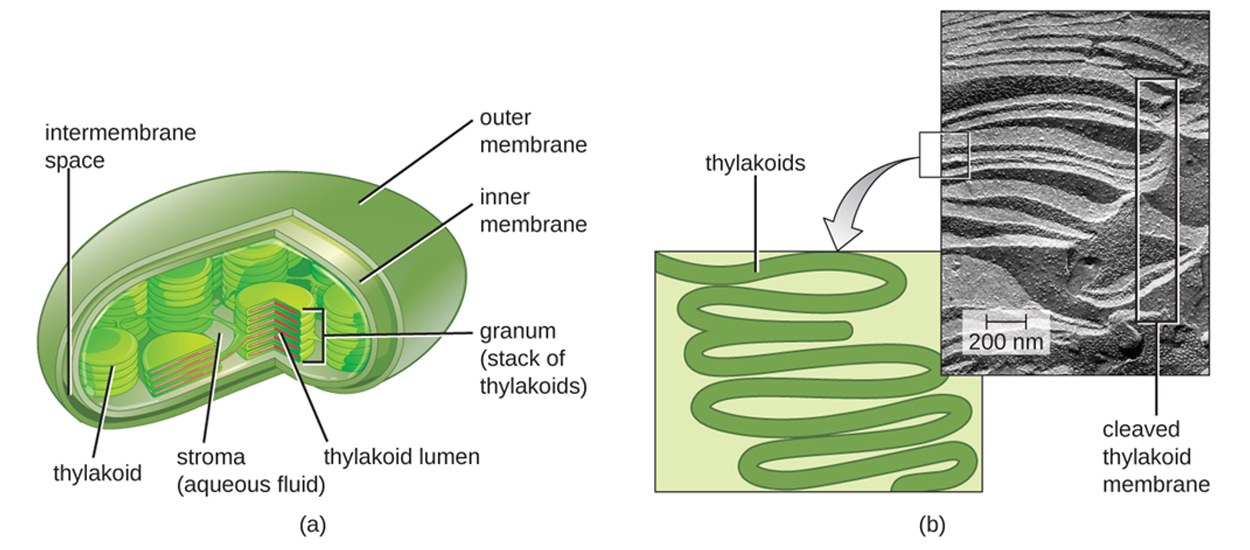
Chloroplasts have an outer membrane, a small intermembrane space, and then an inner membrane. Inside the inner membrane, they have stacks of disk-shaped thylakoids. Each disk is called a granum (plural = grana) and the fluid-filled space surrounding the grana is called the stroma. Each thylakoid has an outer membrane and an open interior region called the lumen.
The photosynthetic pigments are located on the thylakoid membranes and are arranged into photosystems. A photosystem consists of chlorophyll pigments arranged in an antenna system that maximizes exposure to light. This system of pigments and associated proteins is called the light-harvesting complex. When light energy hits a pigment, the energy can be transferred from one pigment to another until it reaches a special chlorophyll molecule called the reaction center. The chlorophyll molecule in the reaction center undergoes oxidation upon excitation and can give up an excited electron. You will learn more about this process in the section of this lesson on the light reactions of photosynthesis.
Prokaryotes also have photosystems that operate similarly, although there can be differences in particular types of prokaryotes. Importantly, the photosystems are arranged on infolded regions of plasma membrane called thylakoids instead of being enclosed within chloroplasts.
Photosynthesis involves two major parts: the light reactions (also called light-dependent reactions) and the light-independent reactions (also called the Calvin cycle). The light reactions use light energy to produce the chemical energy to power light-independent reactions.
The table below summarizes the stages of photosynthesis in green plants, which will be explained in more detail below. Note that the light reactions produce ATP and NADPH that are used by light-independent reactions. Light-independent reactions then produce the molecules needed for light reactions to continue. Oxygen is released into the atmosphere and carbon dioxide is taken in from the atmosphere.
| Stages of Photosynthesis in Green Plants | |||
|---|---|---|---|
| Location | Inputs | Outputs | |
| Light reactions | Thylakoid membranes |
Light energy, ADP,  (inorganic phosphate), (inorganic phosphate), 
|
ATP, NADPH, 
|
| Light-independent reactions | Stroma (eukaryotes) |
 , ATP, NADPH , ATP, NADPH
|
ADP,  , organic molecules , organic molecules
|
The image below shows a simplified illustration of photosynthesis, indicating the inputs and outputs of each stage.
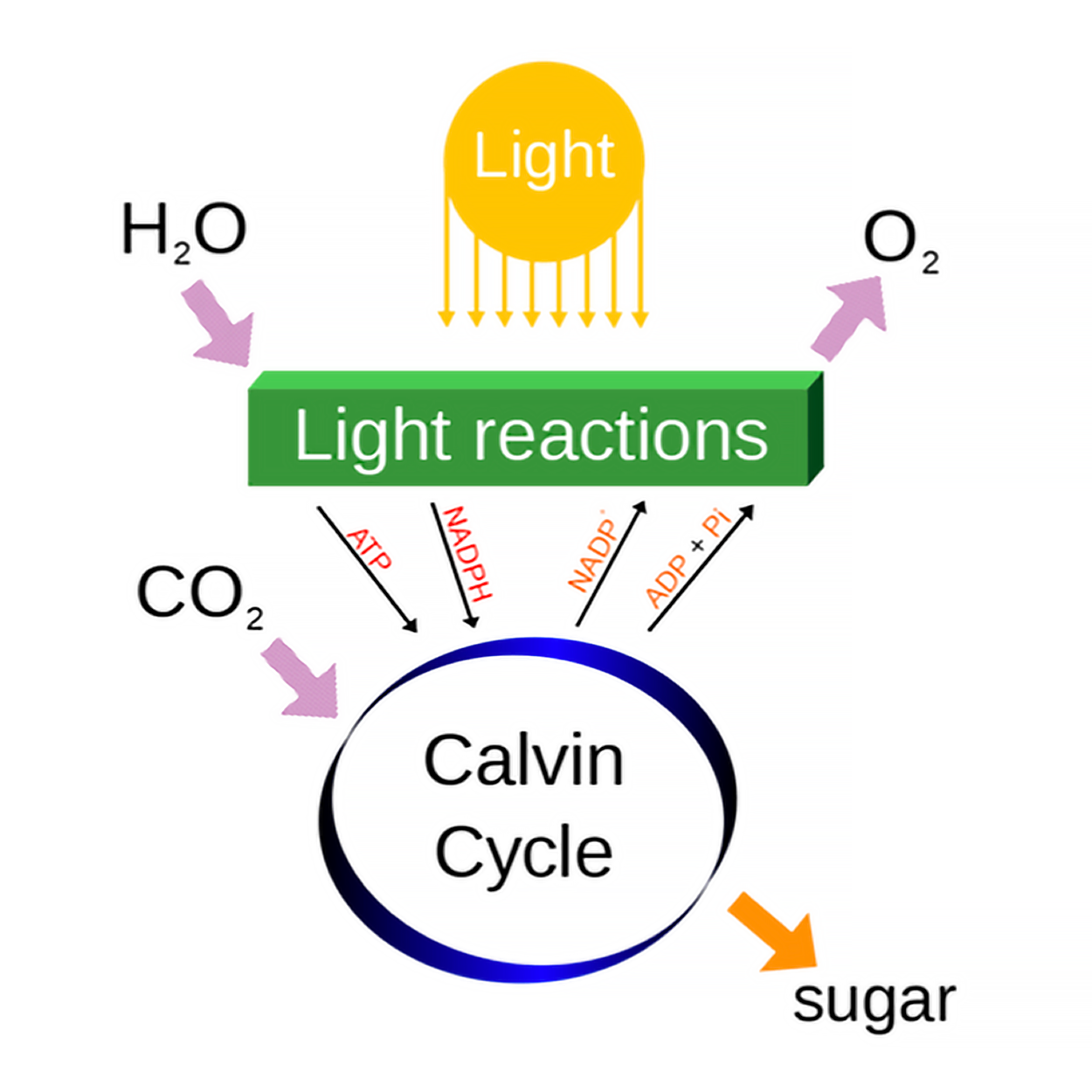
The image below illustrates the points in the table by showing where each step takes place in a chloroplast. Note that the light-independent reactions are labeled as “ fixation” because that is the first step of those reactions.
fixation” because that is the first step of those reactions.
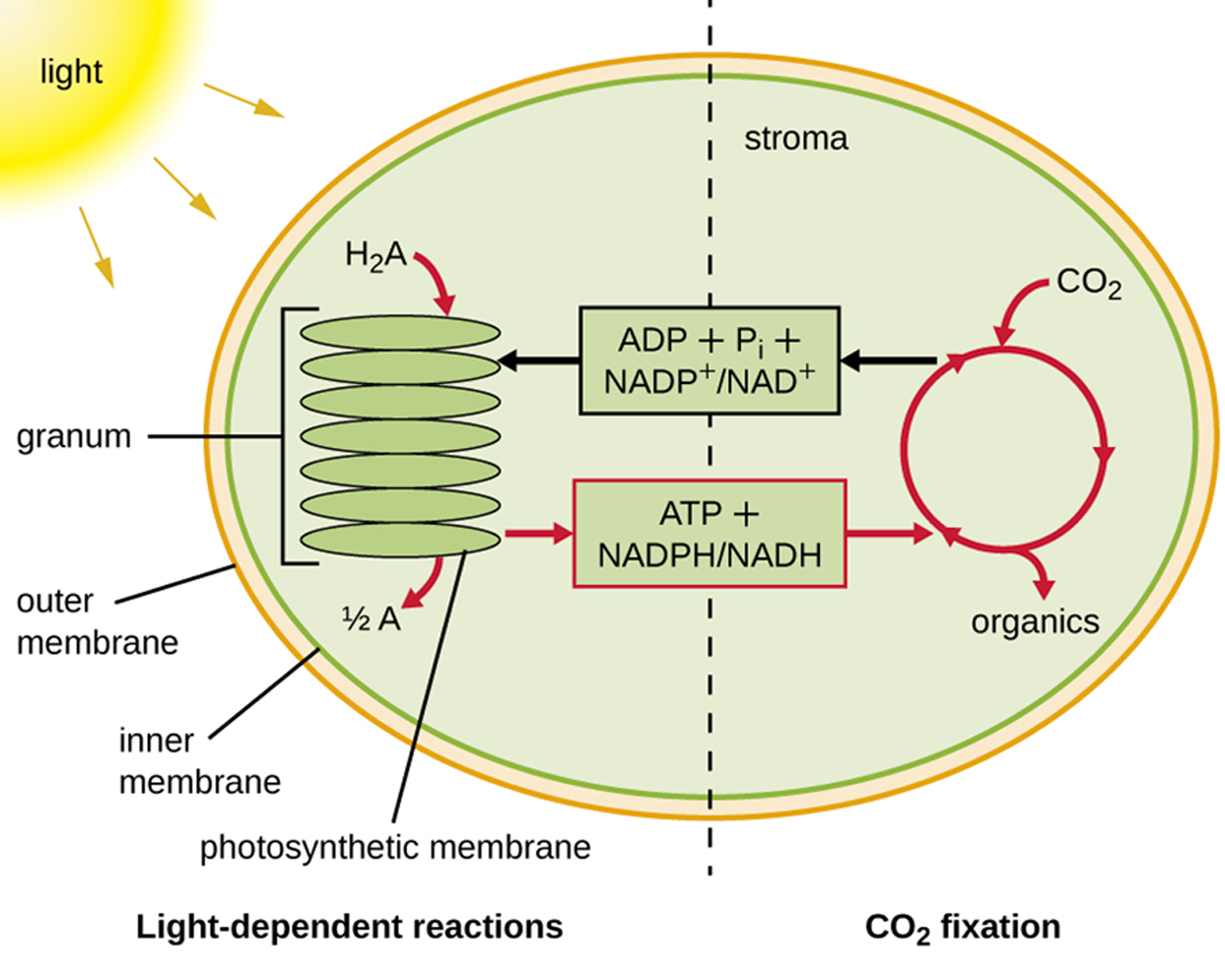
The first part of photosynthesis is the light reactions. To understand light reactions, we need to understand the role of photosynthetic pigments.
Pigments vary in color and each color absorbs a unique pattern of wavelengths (colors) of light. When leaves change colors in the autumn, the reason is that the prominent green chlorophyll molecules break down and other pigments become more visible. Each pigment reflects the colors that it cannot absorb, making it appear that color. Examples of pigments include bacteriochlorophylls (green, purple, or red), carotenoids (orange, red, or yellow), chlorophylls (green), phycocyanins (blue), and phycoerythrins (red). The exact pigments vary by organism, but having a mix of pigments maximizes the wavelengths of light that can be absorbed. Additionally, organisms benefit from having pigments that are highly effective at absorbing the wavelengths of light that are most common in their environments.
Once the energy reaches the reaction center and the high-energy electron departs, the electron is delivered to an electron carrier in an electron transport chain on the thylakoid membrane and electron transfer begins. Although the specific electron acceptors differ, the basic process is similar to electron transfer in cellular respiration. The electron is used to produce NADH or NADPH. Additionally, the electrochemical gradient that forms across the photosynthetic membrane is used to generate ATP by chemiosmosis through photophosphorylation, which is a type of oxidative phosphorylation that uses light energy.
When an electron leaves the reaction center chlorophyll, it produces a vacancy. In some cases, this vacancy is filled by splitting water to release an electron. This process also releases oxygen, which is why plants are known for producing oxygen. When this happens, the term oxygenic photosynthesis is used.
Some bacterial prototrophs use other electron donors and do not produce oxygen. For example, some use hydrogen sulfide ( ) to produce elemental sulfur or thiosulfate (
) to produce elemental sulfur or thiosulfate ( ) to produce sulfate (
) to produce sulfate ( ). When oxygen is not produced, the process is called anoxygenic photosynthesis.
). When oxygen is not produced, the process is called anoxygenic photosynthesis.
The image below compares oxygenic and anoxygenic photosynthesis. In this image, “A” represents an atom other than oxygen.

There are two major types of photosystems: photosystem I (PS I) and photosystem II (PS II). Both systems are present in plant chloroplasts and cyanobacteria, but anoxygenic photosynthetic bacteria use only one of them.
There are also two types of photophosphorylation that can be used. Noncyclic photophosphorylation involves both photosystems and produces ATP and NADPH. When an excited electron leaves the PS II reaction center, it travels through an electron transport system to produce ATP and fill a vacancy in a reaction center in PS I. This vacancy was produced by an excited electron that was picked up by  to form NADPH. This flow of electrons is called the Z scheme.
to form NADPH. This flow of electrons is called the Z scheme.
If a cell needs significantly more ATP than NADPH, then it can use PS I alone to carry out cyclic photophosphorylation. In this process, the excited electron passes through an electron transport system to produce ATP and then returns to the reaction center from which it started.
The image below shows an example of an electron transport chain on a thylakoid membrane in part (a). Part (b) shows the steps of cyclic photosynthesis and noncyclic photosynthesis. Although part (b) may appear complex, focus on the arrows labeled noncyclic photosynthesis and cyclic photosynthesis to follow the path of the electron in a circle (in cyclic photosynthesis) or from PS II to PS I (in noncyclic photosynthesis) as those are the most important concepts to understand.
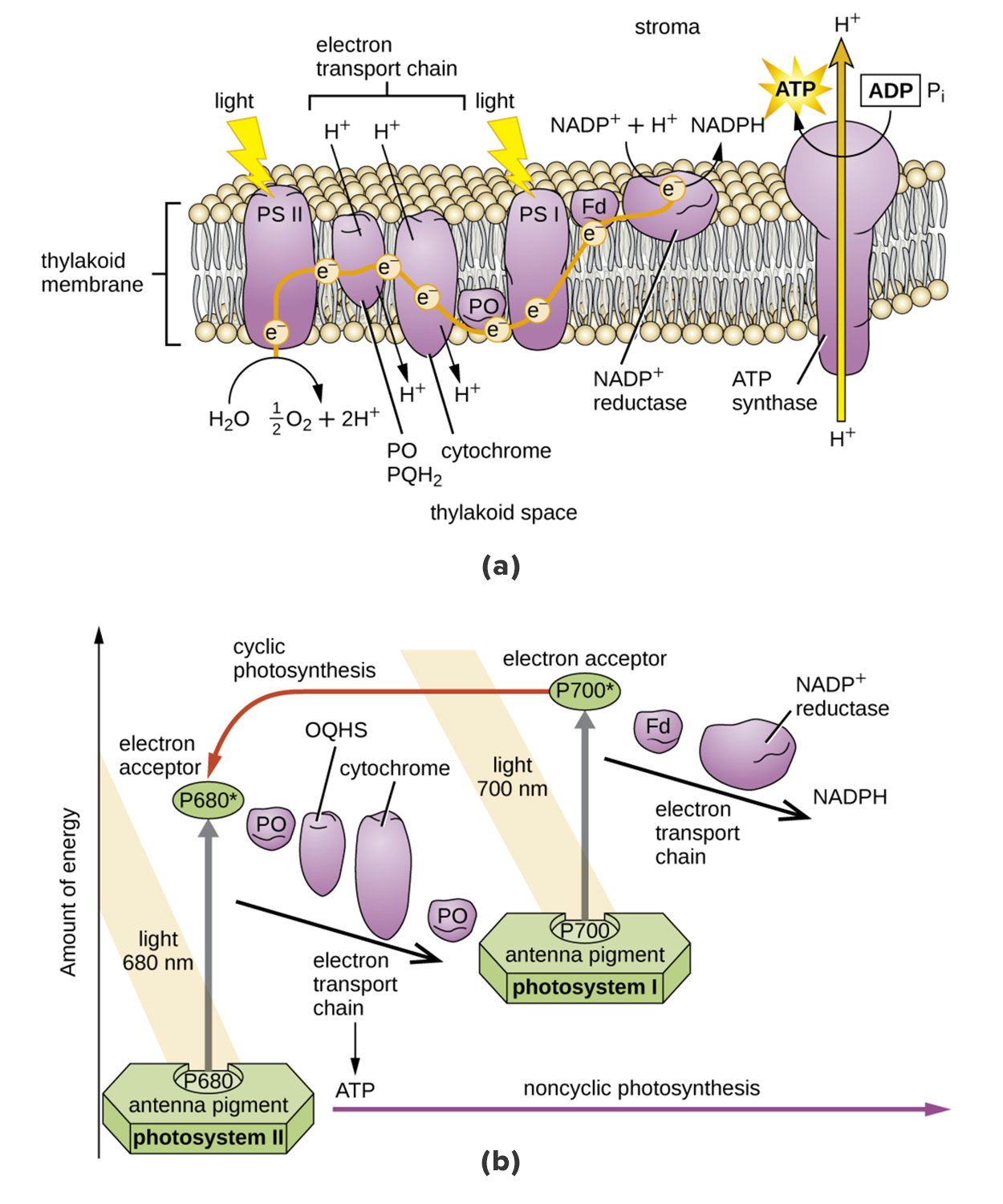
After the light reactions produce ATP and/or NADPH, the light-independent reactions begin. These reactions use the chemical energy produced by the light reactions and carbon dioxide from the atmosphere to produce organic molecules.
The light-independent reactions are also sometimes called the Calvin cycle, the Calvin-Benson cycle, or the dark reactions. The term dark reactions is generally avoided as it misleadingly suggests that the reactions only take place in the dark.
There are three major steps in light-independent reactions. They are described in the steps below. In the image below, the cycle is divided into three color-coded parts to illustrate these three phases, labeled in order as 1 through 3. Note that fixation means using an inorganic molecule (in this case, carbon dioxide) to form an organic molecule.
 to ribulose bisphosphate (RuBP). This results in the production of 3-phosphoglycerate (3-PGA).
to ribulose bisphosphate (RuBP). This results in the production of 3-phosphoglycerate (3-PGA). fixation. Three more molecules of ATP are used in these regeneration reactions.
fixation. Three more molecules of ATP are used in these regeneration reactions.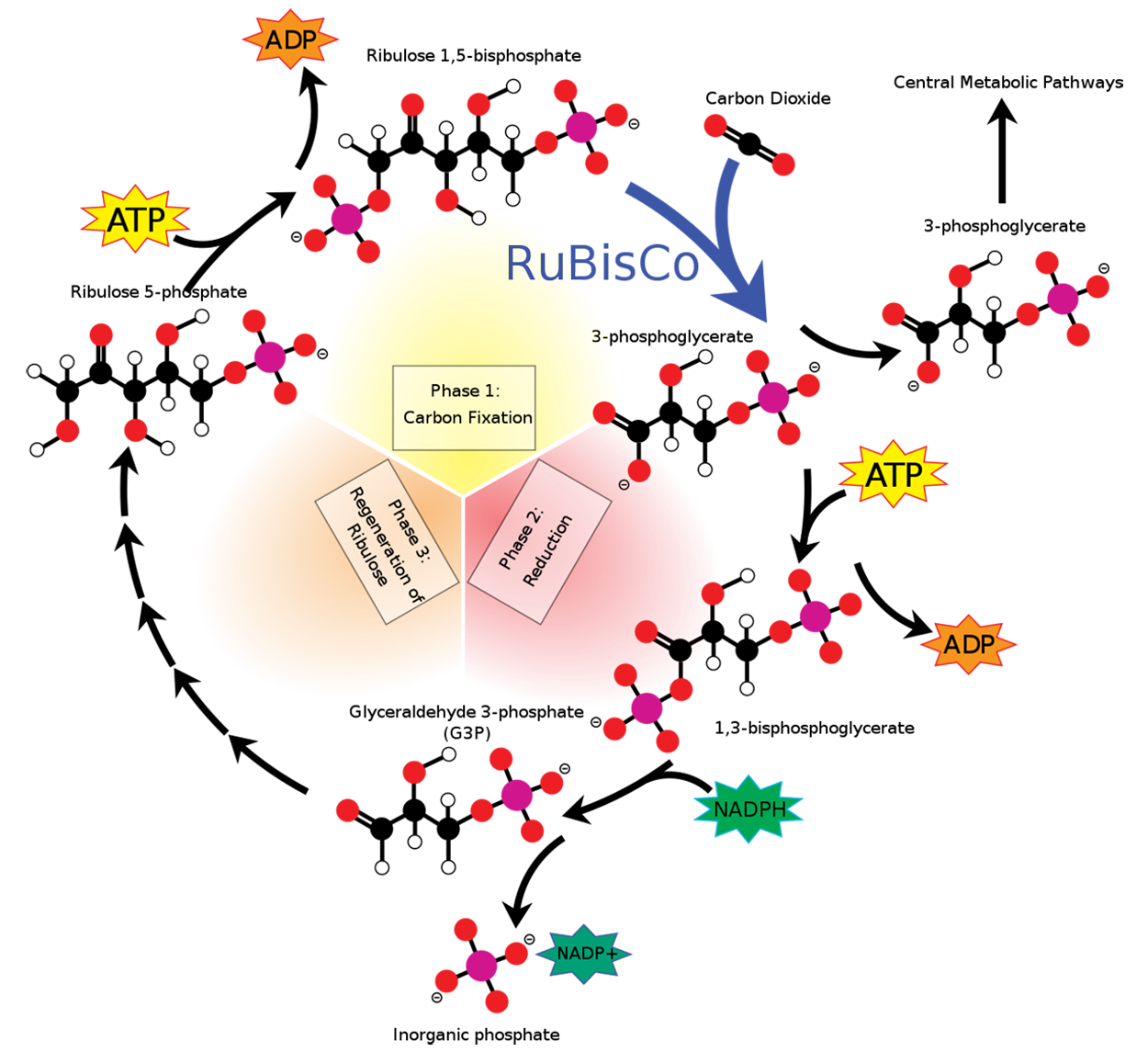
The light-independent reactions are extremely common in nature, used by both plants and photoautotrophic bacteria. Many nonphotosynthetic chemoautotrophs also use these reactions to fix  . Some microbes use alternative pathways for
. Some microbes use alternative pathways for  fixation.
fixation.
Source: THIS TUTORIAL HAS BEEN ADAPTED FROM OPENSTAX “MICROBIOLOGY.” ACCESS FOR FREE AT openstax.org/details/books/microbiology. LICENSE: CC ATTRIBUTION 4.0 INTERNATIONAL.